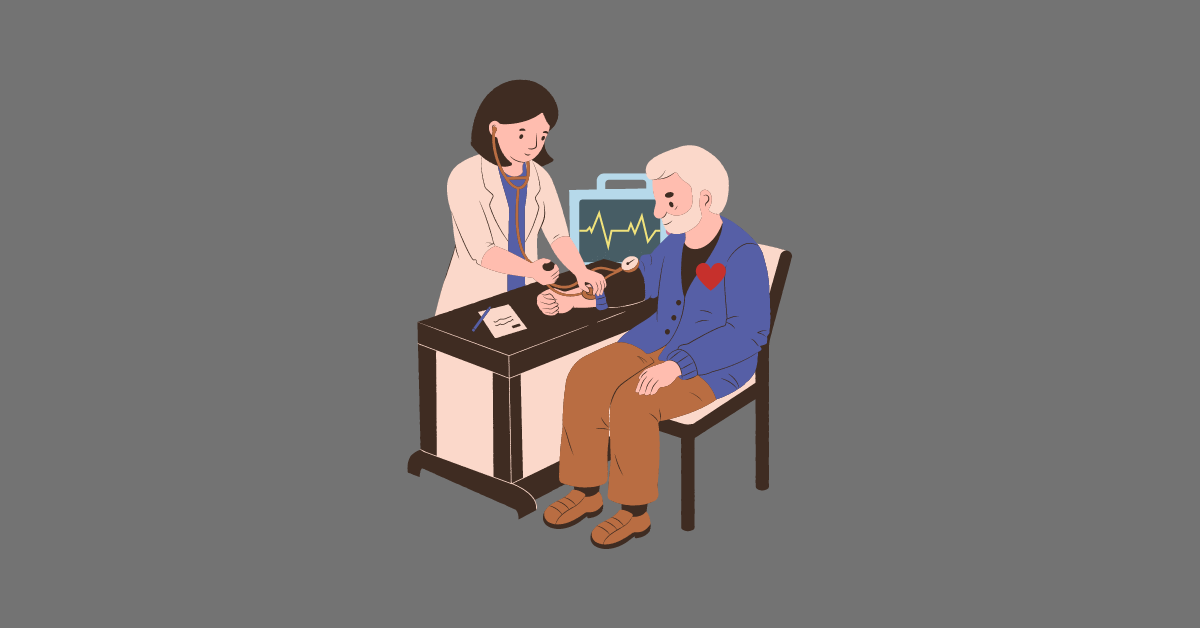7 Things You Should Know About Heart Disease

The words heart disease and heart health are thrown around a lot when it comes to discussing one's health. There are lots of fears and questions surrounding it and rightfully so. According to the CDC, one in every four deaths in the United States is from heart disease. Furthermore, it is the number one killer for adults in the United States. When someone you love or yourself is diagnosed with one of these diseases you may experience shock, fear, and confusion. Heart disease is known as a silent killer for a reason and it lives up to that name well. So in this article, we will be covering 7 things you should know about heart disease.
1. What Causes Heart Disease?
The three key risk factors for heart disease are high blood pressure, high cholesterol, and smoking. High blood pressure puts increased strain on your heart as it pumps blood throughout your body. HBP can weaken your heart to the point where it can’t properly push blood to the rest of your body. Cholesterol is a waxy, fat-like substance made in the liver or found in different foods we eat. When extra cholesterol is made or digested it builds up in the walls of our arteries which leads to a narrowing and decreased blood flow to important parts of the body. Both of these risk factors are difficult to detect due to their lack of external symptoms but can be monitored via blood pressure cuffs and blood testing respectively. The final key risk factor, Tobacco use, can increase your risk of heart disease for a variety of reasons. Cigarette smoke damages the heart and blood vessels, nicotine raises blood pressure, and carbon monoxide from cigarette smoke reduces the amount of oxygen your blood can carry throughout your body.
2. What Are Some of The Common Types of Heart Disease?
- Cardiomyopathy is a disease of the heart muscles that makes it harder for your heart to pump blood to the rest of the body. Chambers become enlarged resulting in suboptimal blood flow throughout the body. Cardiomyopathy is typically caused by viral infections in the heart or genetics.
- Congenital Heart Disease is a broad term for a wide range of heart birth defects that develop before birth. This can include defective vessels, leaky valves, and even holes in the heart. Serious cases require a heart transplant but in other cases, less invasive surgeries or treatments can be done. These conditions are relatively rare with less than 200,000 cases in the U.S. per year.
- Coronary Artery Disease, also often called atherosclerotic heart disease, is the damage or disease in the heart’s major blood vessels. This is often caused by the buildup of fat deposits called plaque that restricts the blood flow to and from the heart. The disease is very common with around 3 million cases in the U.S. per year.
- Heart Arrhythmia is an irregular heartbeat. This is caused by a malfunction of the heart's electrical field which will cause it to beat too fast, too slow, or out of rhythm. The most common type is Atrial fibrillation (A-Fib). This condition affects around 3 million Americans per year. Minor cases can be harder to detect due to a lack of symptoms while more serious cases are treated with procedures, implants, or medication.
- Heart Failure, sometimes called congestive heart failure, is a chronic condition in which the heart doesn’t pump blood properly. This is due to either stiff and thickening of chambers or the stretching and thinning of chambers in the heart. It is a chronic heart condition that is common with more than 200,000 cases in the U.S. per year.
- Heart Valve Disease occurs when the valves in the heart do not function properly. Though there are several different types of heart valve diseases the two most common are valvular stenosis which occurs when the valve does not fully open due to stiff or fused leaflets. The other is valvular insufficiency which is when a valve does not close tightly, often called a “leaky valve”. These conditions affect about 5 million Americans according to the American Heart Association.
- Pericardial Disease is the inflammation of any layers of the pericardium, a thin tissue sac that surrounds the heart. The pericardial is broken down into three layers, the visceral pericardium which is the inner layer that envelops the heat, the middle fluid layer that separates the upper and lower layers, then the parietal pericardium is the outer, fibrous tissue. Symptoms include chest pains, increased heart rate, and a low-grade fever.
3. What Are The Common Sings of Heart Disease?
Unlike many other diseases, heart disease can be hard to detect due to its lack of present symptoms. However, the three most common signs/symptoms of heart disease are
- Arrhythmia
- Heart Attacks
- Heart Failure.
Arrhythmia is simply the improper beating of the heart which is due to electrical impulses in the heart not working properly. They are extremely common with over 3 million cases in the United States alone (Mayo Foundation, 2021). A common type of Arrhythmia is Atrial Fibrillation, also called A-Fib. Atrial Fibrillation is an irregular and often rapid heart rhythm that can lead to blood clots in the heart. The heart's upper chambers (atria) beat out of sync with the lower chambers(ventricles) giving the condition its name. Those with Arrhythmia often feel a fluttering sensation in their chest or palpitations.
The next common symptom is a heart attack, also called a myocardial infarction. Heart attacks happen when part of the heart does not get enough blood. Symptoms include tightness or pain in the chest, Heartburn, nausea, and vomiting are also common symptoms. Along with dizziness, extreme fatigue, and shortness of breath. Heart attacks can be deadly and it is best to get to the emergency room if you or a loved one is experiencing such symptoms.
The final symptom is heart failure which is when the heart cannot pump enough blood and oxygen to support other organs in the body. When someone is experiencing heart failure they will often have symptoms such as shortness of breath both during daily activities and lying down. Unexpected weight gain with swelling in areas such as feet, ankles, legs, and stomach is also a common symptom. Additionally general feelings of tiredness or weakness.
4. What Behaviors Increase The Risk of Heart Disease?
The biggest and most controllable factor for heart disease is your lifestyle. Eating a diet that is high in fats and cholesterol is linked to heart disease and related conditions. These types of foods result in an increase in the production of cholesterol in your bloodstream which can build up and narrow arteries. Also, it is best to avoid large amounts of salt due to it increasing blood pressure. Not getting enough physical activity can lead to heart disease. It also increases your chances of developing other medical conditions that are risk factors such as obesity, high cholesterol, diabetes, and high blood pressure. Next, drinking too much alcohol can raise your blood pressure levels and put you at risk for heart disease. It is suggested that you limit your alcohol consumption to about one or two drinks per day maximum. Furthermore, alcohol leads to an increase in levels of triglycerides which are fatty substances in the blood linked to heart disease. As mentioned in number one tobacco use is a huge and final risk when it comes to heart disease. The smoke and nicotine cause damage to your heart and arteries which can be extremely difficult to undo. Secondhand smoke also increases your risk of heart disease. Changing these behaviors can greatly decrease your risk of heart disease.
5. Are Genetics A Risk Factor?
Genetics can play a role in developing heart disease however there are often other risk factors at play. If you have a family history of heart disease it is important to evaluate whether they shared a common environment or similar unhealthy lifestyle choices. Now when heredity and unhealthy living choices combine there is an increase in risk for heart disease but it is unlikely to develop just on heredity alone.
6. What Are The Treamtents For Heart Disease?
Treatments for heart disease vary depending on the condition and severity of it. Common treatments include lifestyle changes, medications, surgery, stents, pacemakers, and ablation.
- Angioplasty is a procedure that uses very little cutting to open up a blocked artery by the heart.
- Cardioversion is done in two different ways. One is a procedure in which a machine sends electrical energy to the heart muscle in an attempt to get your heart beating in a proper rhythm. For less serious cases medication may be prescribed or given through an IV to help slow or quicken your heartbeat.
- Cardiopulmonary Resuscitation (CPR) is the repeated compression of a patient’s chest, performed in an attempt to restore the blood circulation and breathing of a person who has suffered cardiac arrest.
- Drug-Eluting Stents is a small metal mesh coil that is placed in a blocked coronary artery. This coil is coated in medication to help reopen an artery and keep it open.
- External Counterpulsation (EECP) is a non-invasive treatment that lowers the number and intensity of angina episodes. Treatment is administered through pairs of inflatable cuffs applied in certain areas of the body.
- Heart Bypass Surgery is when a surgeon takes blood vessels from another part of a patient's body and goes around a blocked artery. This allows for more blood and oxygen flow to the heart.
- A Heart Transplant is a surgical transplant procedure performed on patients with end-stage heart failure or severe coronary artery disease. The diseased or failing heart is removed from the body and a healthy donor's heart is then put in place.
- Implantable Cardioverter Defibrillators are small battery-powered devices placed in the chest to detect and stop irregular heartbeats. The ICD continuously monitors the heartbeat and delivers electric shocks to restore a regular heart rhythm.
- Stents are small mesh tubes that hold open passages in the body such as weak or narrow arteries.
- Ventricular Assist Device is a device that is implanted in your chest to help pump blood from your lower heart chambers to the rest of your body.
7. Can Heart Disease Be Cured?
Heart disease cannot be cured but treatments such as the above can help manage the symptoms and reduce the chances of problems such as heart attacks. The best treatments are to make lifestyle changes and prevent your risk of heart disease. Regular exercise and decreasing your intake of unhealthy, especially fatty, foods is the best way to prevent heart disease.
Sources:
Mayo Foundation for Medical Education and Research. (2021, October 1). Heart arrhythmia. Mayo Clinic. Retrieved March 3, 2022, from https://www.mayoclinic.org/diseases-conditions/heart-arrhythmia/symptoms-causes/syc-20350668?utm_source=Google&utm_medium=abstract&utm_content=Cardiac-arrhythmia&utm_campaign=Knowledge-panel
Centers for Disease Control and Prevention. (2021, September 27). About heart disease. Centers for Disease Control and Prevention. Retrieved March 18, 2022, from https://www.cdc.gov/heartdisease/about.htm

Matthew Laming
Client Relations Specialist at GLHCU. Graduate of Northwood University. General Geek and Nerd Enthusiast.
Recent Comments